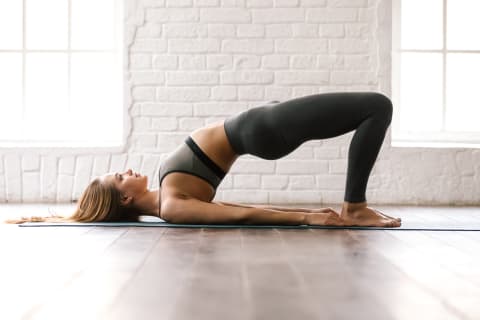While both phases, or types, of exercise are valuable, most people tend to pay less attention to eccentric movement (be honest: You’ve let your arm drop at the end of a biceps curl rep)—which can lead to injury. To better understand the benefits and potential risks of improper eccentric muscle contraction, mbg reached out to fitness trainers and physical therapists. “Eccentrics, in a nutshell, is the art of lowering a weight as slowly as you can,” says Antonio Lombardo, P.T., DPT, physical therapist at Professional Physical Therapy. Nearly all lowering motions in a strength exercise, like the downward motion of a squat, the downward motion of a pushup, the downward motion of a biceps curl, are examples of eccentric muscle contractions, ACE-certified personal trainer Stephanie Thomas, tells mbg. “To work the eccentric phase of an exercise, you want to concentrate on the motion and perform it slowly,” she adds. Working the negative phase of an exercise helps the muscle become stronger, Thomas adds, which may make it increase in size faster. Concentric movements are more effective at increasing maximum power output (aka the ability to exert more energy in a short amount of time), Danielle Gray, NASM-CPT, and founder of Train Like a Gymnast, previously said, whereas, eccentric movements are thought to cause more micro-tears in muscles, which is necessary for building muscle. 2. Lowering the arms during a biceps curl How to do it: After raising the dumbbell up to your shoulders during a biceps curl, slowly lower the weight back down to your side. 3. Lowering down from a pull-up or chin-up How to do it: After your chin has raised above the bar (in either a chin-up or a pull-up), begin to straighten your arms as you lower down, slowly and with control. How to do it: Start in a bridge position (pictured above); with your weight on your heels, begin walking your feet away from your body. Once your feet are as far away as they can get without sacrificing the correct form, begin walking them back toward your body. 2. Supine hamstring slide-out (unilateral or bilateral) How to do it: Start in a bridge position; place a hand towel or sliders underneath your heels. With your weight on your heels, slowly slide your feet away from the body. This is similar to the walkouts, but you’re sliding instead of walking. You can do this move unilaterally (with one foot) or bilaterally (with both). 3. Nordic drop How to do it: Begin in a kneeling position; have someone hold your ankles for added support; cross your arms in front of your chest and slowly begin leaning forward with your back straight. Note: This move is challenging and may take practice to build up to (reverse Nordic drops are a bit easier, according to Arrington). 2. Reverse Nordic drop How to do it: Start in a kneeling position, with your arms crossed over your chest; slowly lean backward, keeping your back straight. “If there is a notable weakness or lack of coordination during eccentrics, a bit more effort and attention to that area would be greatly beneficial,” she says. It’s also important to note that eccentric exercise tends to leave people more sore than concentric exercise because it causes muscle damage (essential for muscle building). “The increase in soreness can discourage [beginners] from continuing with their workout program, as muscles can remain sore for several days after an exercise,” Thomas says. While soreness in and of itself is not a bad thing, if it keeps you from being active, it may be best to limit eccentric exercise to fewer days of the week and consider cross-training with light walks, yoga stretches, or other soothing physical activities. “With proper rest, hydration, and sleep, you’ll be back on your feet just in time for your next workout,” Lombardo says.



